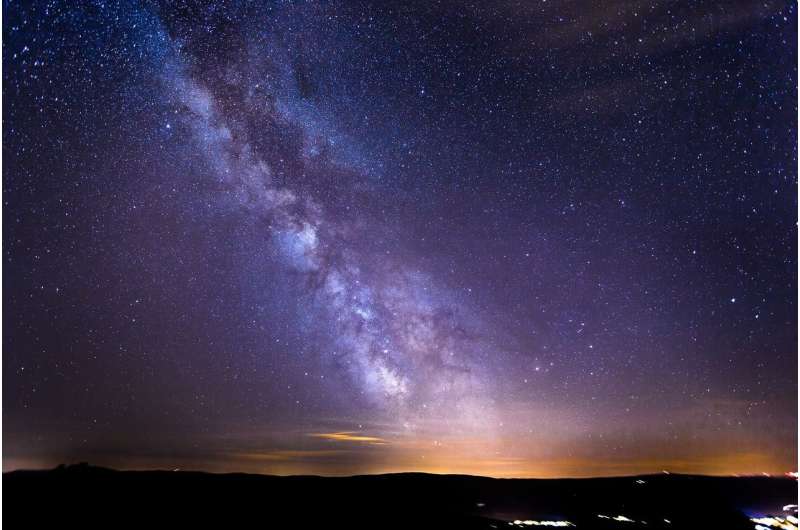This article has been reviewed according to Science X's editorial process and policies. Editors have highlighted the following attributes while ensuring the content's credibility:
fact-checked
peer-reviewed publication
trusted source
proofread
Ancient duo of stars visiting from far reaches of the Milky Way discovered

An unusual pair of 10-billion-year-old stars, formed when the Milky Way was young, are visiting from the farthest reaches of the galaxy, researchers have discovered.
The international team of experts from the UK, Spain and China, including from the University of Hertfordshire, were examining stars close to Earth when they discovered the binary star system—two stars that are gravitationally bound. To their surprise, they found the pair had traveled from the Milky Way halo to our local stellar neighborhood.
The work was published in the Monthly Notices of the Royal Astronomical Society as the 8th paper of a series titled "Primeval very low-mass stars and brown dwarfs."
The pair consists of a white dwarf and an ultracool subdwarf, with very large motions that indicate they spend most of their time far from the visible stars in our galaxy.
The team used the mass of the white dwarf (named VVV1256-62A) and how much it has cooled by to calculate its age. This particular star is roughly half the mass of our sun and is located near the bottom of the white dwarf cooling sequence, meaning it has taken billions of years to cool down.
A white dwarf is formed at the end of the evolution of a regular star and, while they are very hot at the start of their lives, they gradually cool off and redden without the active fusion that keeps other stars going.
Meanwhile, the other star, (named VVV1256-62B), is a low-metallicity subdwarf, meaning it does not contain many elements heavier than hydrogen and helium. While harder to age so directly, low metallicities are themselves an indication of great age, because there were very few heavier elements in the early stage of the Milky Way, when they were formed.
If a star lacks these heavier elements, it can give us hints of the very distant past of the Milky Way galaxy. This subdwarf is particularly interesting since it lies at the boundary between stellar and substellar objects. This makes it an age benchmark for studying metal-poor ultracool atmospheres.
This binary system is also interesting because it has a highly eccentric orbit, meaning that the distance between the two stars varies significantly. This is why the stars are usually in the Milky Way halo, but their orbit also takes them into the Milky Way plane, the central area of the galaxy where most of its mass lies.
The ultracool subdwarf component of this binary system was originally identified due to its large motion by University of Hertfordshire Ph.D. student Leigh Smith and confirmed as an ultracool subdwarf by ex-University of Hertfordshire Ph.D. student Zenghua Zhang.
Its white dwarf companion and binary nature were then discovered in parallel by Sayan Baig, a current Ph.D. student at the University of Hertfordshire, and Zenghua Zhang, who now has a faculty position at Nanjing University.
Telescopes across the world were used to confirm these discoveries, including the Gemini South telescope, one half of the International Gemini Observatory, supported in part by the U.S. National Science Foundation (NFS).
The Very Large Telescope of the European Southern Observatory and the Dark Energy Camera Plane Survey of the Blanco telescope at the Cerro Tololo Inter-American Observatory in Chile were also involved.
Professor Hugh Jones, professor of astronomy at the University of Hertfordshire, said, "These fascinating discoveries open a window into the farthest reaches of our galaxy.
"Understanding the link between the halo and the plane of the Milky Way is a step towards understanding how the galaxy was formed. While the massive, eccentric orbit of these stars has yet to be explained, it could be related to the existence of an inner halo or to a past merger of the Milky Way with another galaxy.
"I'm immensely proud of the current and former University of Hertfordshire students who have been involved in this phenomenal discovery."
More information: Z H Zhang et al, Primeval very low-mass stars and brown dwarfs – VIII. The first age benchmark L subdwarf, a wide companion to a halo white dwarf, Monthly Notices of the Royal Astronomical Society (2024). DOI: 10.1093/mnras/stae1851. On arXiv: arxiv.org/abs/2407.19219
About the discovery: European Space Agency's webpage about the star system.
Journal information: Monthly Notices of the Royal Astronomical Society , arXiv
Provided by University of Hertfordshire





















